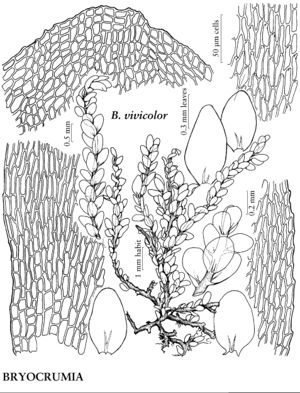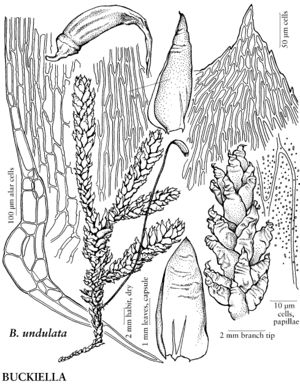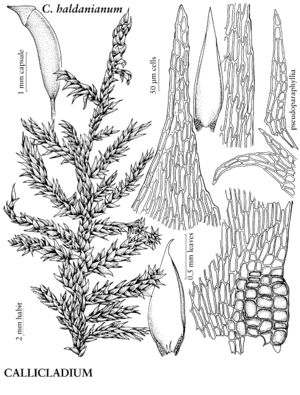Difference between revisions of "Hypnaceae"
imported>Volume Importer |
imported>Volume Importer |
||
| Line 198: | Line 198: | ||
|publication year= | |publication year= | ||
|special status= | |special status= | ||
| − | |source xml=https:// | + | |source xml=https://bitbucket.org/aafc-mbb/fna-data-curation/src/2e0870ddd59836b60bcf96646a41e87ea5a5943a/coarse_grained_fna_xml/V28/V28_799.xml |
}}<!-- | }}<!-- | ||
-->[[Category:Treatment]] | -->[[Category:Treatment]] | ||
Latest revision as of 21:38, 5 November 2020
Plants small to large, lax to dense, in tufts or mats, dark green, yellow-green, golden green, or orange, sometimes reddish brown or nearly black, often lustrous. Stems creeping, suberect, or erect, occasionally complanate-foliate or julaceous, irregularly branched to regularly 1- or 2-pinnate; hyalodermis 1-stratose or absent, central strand present or absent; pseudoparaphyllia filamentous, foliose, or absent; rhizoids often in clusters proximal to juncture of leaves on adaxial surface of stems and branches, smooth or papillose; axillary hair basal cells 1–2(–4), short, brown, distal cells 1–several, elongate, hyaline. Stem and branch leaves similar or less commonly differentiated, straight to homomallous, often falcate-secund, usually ovate-lanceolate, often asymmetric, sometimes linear, lanceolate, or triangular, occasionally plicate; base sometimes decurrent; margins often plane, occasionally recurved proximally or throughout, entire or toothed; apex obtuse to acuminate; costa double, short, to obscure or ecostate; alar cells usually differentiated, often quadrate to short-rectangular, sometimes enlarged and inflated, pigmented or similar in color to other cells, excavate or plane; medial and distal laminal cells linear, hexagonal, or elongate-sinuate, smooth, sometimes prorulose at distal ends on abaxial surface. Specialized asexual reproduction sometimes by leafy propagula or filamentous gemmae clustered in leaf axils. Sexual condition autoicous, dioicous, or phyllodioicous. Seta elongate, smooth (occasionally scabrous near capsule in Ctenidium). Capsule inclined, horizontal, or sometimes erect, cylindric or ovoid, usually smooth, often constricted below mouth when dry and empty; operculum conic or rostrate; peristome usually double; exostome teeth 16, external surface cross striate basally, papillose distally, sometimes bordered, internal surface often trabeculate; endostome usually free, sometimes fused to exostome, basal membrane high or rarely low, segments 16, cilia 1–3, nodose, rarely rudimentary or absent. Calyptra cucullate, smooth (weakly prorulose distally in Ctenidium), naked or rarely hairy. Spores spheric to ovoid, usually finely papillose, rarely smooth.
Distribution
Nearly worldwide, most diverse in subtropics and tropics.
Discussion
Genera 60, species ca. 600 (19 genera, 62 species in the flora).
Hypnaceae are taxonomically problematic; the family once held a high proportion of pleurocarpous species, but as genera are monographed, they are often placed in other families. The distinctive hypnoid peristome has been used as a significant feature, but this is not entirely reliable.
Selected References
None.
Lower Taxa
Illustrations
| Family ⠉ | Taxon | Illustrator ⠉ | |
|---|---|---|---|
 | Hypnaceae | Bryocrumia vivicolor | Patricia M. Eckel |
 | Hypnaceae | Buckiella undulata | Patricia M. Eckel |
 | Hypnaceae | Callicladium haldaneanum | Patricia M. Eckel |
| ... further results | |||
Key
| 1 | Stems with hyalodermis present, sometimes indistinct | > 2 |
| 1 | Stems with hyalodermis absent | > 5 |
| 2 | Laminal cells minutely granular papillose; plants large; leaves undulate. | Buckiella |
| 2 | Laminal cells smooth or rarely minutely prorulose; plants small to medium-sized; leaves not undulate | > 3 |
| 3 | Pseudoparaphyllia present, filamentous to foliose. | Hypnum |
| 3 | Pseudoparaphyllia absent (present in Herzogiella adscendens) | > 4 |
| 4 | Leaf margins serrulate to serrate (serrulate to entire in H. adscendens); asexual propagula absent. | Herzogiella |
| 4 | Leaf margins entire or minutely serrulate; asexual propagula sometimes present. | Isopterygiopsis |
| 5 | Laminal cells with abaxial surface prominently prorulose | > 6 |
| 5 | Laminal cells smooth or prorulose | > 7 |
| 6 | Laminal cells prorulose at distal and sometimes proximal ends; leaves straight. | Chryso-hypnum |
| 6 | Laminal cells prorulose at distal ends; leaves falcate. | Ctenidium |
| 7 | Basal row of laminal cells with 1 large prorula at proximal end on abaxial surface. | Dacryophyllum |
| 7 | Basal row of laminal cells smooth | > 8 |
| 8 | Leaf apices bluntly obtuse to broadly acute. | Bryocrumia |
| 8 | Leaf apices acute to acuminate, rarely subobtuse | > 9 |
| 9 | Lateral and dorsal leaf shape strongly differentiated | > 10 |
| 9 | Lateral and dorsal leaf shape not strongly differentiated | > 11 |
| 10 | Laminal cell walls thick; medial cells linear. | Gollania |
| 10 | Laminal cell walls thin; medial cells at least of lateral leaves relatively short. | Vesicularia |
| 11 | Brood branchlets present at branch apices. | Platygyrium |
| 11 | Brood branchlets absent at branch apices | > 12 |
| 12 | Pseudoparaphyllia filamentous, 1 (or 2)-seriate at base. | Isopterygium |
| 12 | Pseudoparaphyllia foliose or absent | > 13 |
| 13 | Distal laminal cells ca. 4-6:1. | Homomallium |
| 13 | Distal laminal cells usually longer than 6:1 | > 14 |
| 14 | Leaves lanceolate to ovate-lanceolate, usually widest at base; alar cells not or poorly differentiated. | Orthothecium |
| 14 | Leaves lanceolate to ovate, widest beyond base; alar cells mostly differentiated | > 15 |
| 15 | Plants large; stems suberect to ascending, pinnate, forming fronds; leaves strongly plicate. | Ptilium |
| 15 | Plants usually small or medium-sized, if large, not forming fronds; stems creeping, irregularly branched or sometimes regularly pinnate; leaves not to weakly plicate | > 16 |
| 16 | Asexual reproductive bodies present in leaf axils, occasionally stem apices. | Pseudotaxiphyllum |
| 16 | Asexual reproductive bodies absent | > 17 |
| 17 | Branches usually strongly curled when dry; capsules erect to suberect, straight; exostome teeth smooth basally. | Pylaisia |
| 17 | Branches not curled when dry; capsules erect to cernuous, often curved; exostome teeth usually cross striolate basally | > 18 |
| 18 | Stems somewhat complanate-foliate; leaf margins entire; capsules suberect or somewhat inclined, not or weakly curved. | Callicladium |
| 18 | Stems not complanate-foliate or if so, leaf margins serrulate to serrate; capsules inclined, usually curved | > 19 |
| 19 | Stems pinnate or irregularly branched, rarely subjulaceous; leaves usually spreading. | Hypnum |
| 19 | Stems simple or sparingly and irregularly branched, sometimes julaceous or subjulaceous; leaves complanate. | Taxiphyllum |